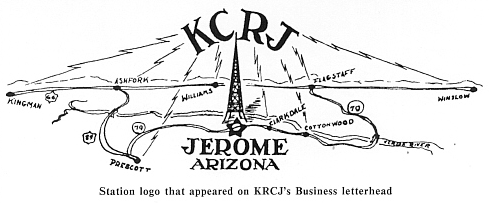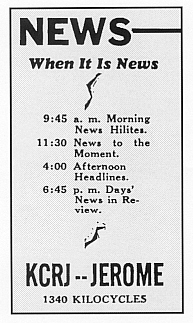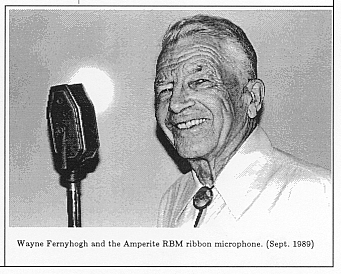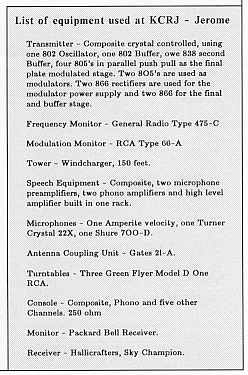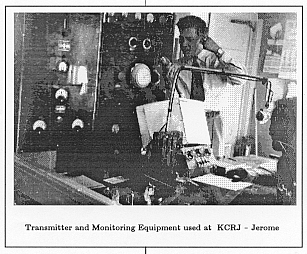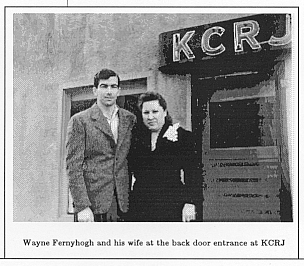KCRJ falls into the classification of the early pre-World War II Arizona stations that we wanted to learn more about. There were much fewer stations in the early days of Arizona due to the lack of population that was present here. The large influx of population that we have now, did not occur until after the war.
Our interest in KCRJ began when we met Wayne Fernyhogh, who from May 15,1941 until July 1, 1944, was the Chief Engineer for KCRJ in Jerome, Arizona. Wayne had come by the museum to look at some of the old radio equipment that we had on display there. We spent several hours chatting about his experiences in radio and electronics and he told us about some of the radio stations that he had worked at throughout the years. We did not go into much detail at that time, but we knew that at a future date we needed to do a more in-depth interview of him.
Time passed and one day Lou Burke came into COMPUTER EXCHANGE (who provides building space for the museum) and after talking with him for awhile about computers, he then mentioned that he was a broadcast consultant and had at one time owned a radio station in Cottonwood known by the call sign of KCRJ - FM. I mentioned to him that I knew a fellow who was the chief engineer at the old KCRJ - AM station in Jerome. Lou then told us that he had invited Wayne to switch on the new KCRJ - FM station, since Wayne was one of the few people that were left around that had worked at the old Jerome station that the FM station was named after.
Lou Burke toured the museum and mentioned that he had an old microphone at home that he thought
we would have interest in.
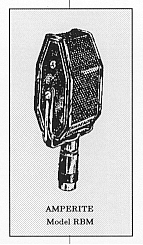
After several days had gone by, Lou returned for another visit with an old Amperite ribbon microphone in his hand. This old microphone it turns out, was given to Lou at the time that Wayne visited him at the new FM station during the opening ceremonies. Lou Burke no longer owned the Cottonwood FM station, in fact it no longer even goes by the call sign of KCRJ anymore. Lou decided that the place for the microphone was in the museum so that many can visit it, a much more fitting place for it than in a desk drawer! In a future issue we will cover how Lou started KCRJ - FM, and although it is a history much more recent than that of KCRJ - AM, this FM station does not have itís original call sign any longer and the history behind it must be recorded.
We invited Wayne Fernyhough over for an interview. Besides bringing himself along, Wayne has a wonderful scrap book he has kept through the years, with material relating to many of the stations that he worked at. In addition to this, Wayne brought along a cassette tape for me to copy that Lou Burke had commissioned on the early days of KCRJ - AM. Lou had used this hour long tape as the opening sign-on for the later day FM station.
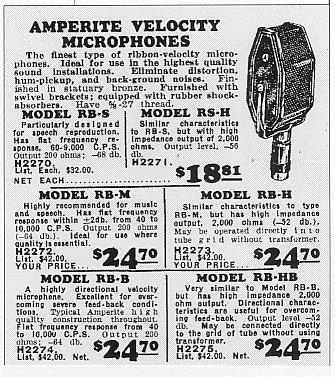
There is very little remaining paperwork or actual equipment left from the old station, since the station was purchased in 1944, and the equipment and all other assets moved back east. We are deeply indebted to Wayne Fernyhough for the use of pictures and some of the data that was used to construct this article from. Lou is to be congratulated for his funding of the KCRJ sign-on tape, that contains an archive of interviews with some of the people that remember the old station and gave their impressions of it. The museum is also happy to have acquired the KCRJ microphone from Lou also.
The museum has in itís archives many old catalogs of radio supplies. In an 1936 Allied Radio catalog I found an ad for the AMPERITE RBM Velocity Microphone. It is reprinted in this article.
Wayne showed us letters that people used to send to KCRJ for reception verification reports. A radio station would get a letter from a listener and then after verifying the information the listener had claimed he heard, send a return letter confirming the reception of that station. The most distant letter that Wayne had received was from Les G. Hopkins of the New Zealand DX Club. Wayne still has the original copy of it in his scrap book and we have a copy of it here on file in the archives at the museum. It must have been really amazing to get a reception report letter from such a great distance away, and especially when you consider that KCRJ was a low powered station! Les Hopkins wrote on the New Zealand DX Club form that there was "noise and static that were bad at times, the tone was good, and there was very little fading."
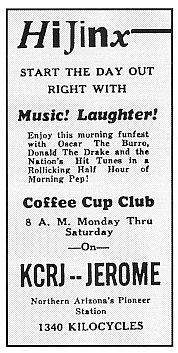
Let us now go back into time. The year is 1928, the place Jerome, Arizona.
Charles Robinson, a man of some means, who was an artist and a jeweler, formed "The Central Arizona Broadcasting System." He applied and received a license to build a radio station in the copper mine boom town of Jerome, Arizona. The stations call letters being KCRJ, meant the following: K- The station was west of the Mississippi river. CR- Obviously stood for Charles Robinson. J - Now this could either stand for jewelers or Jerome, perhaps we will never know which! KCRJ was licensed to broadcast on a frequency of 1340 Kilocycles.
Brandon Delany, KCRJ-FMís news and public affairs director interviewed Louis J. McDonald from Northern Arizona University, who was the executive director of University relations at back in 1981. The following is from that interview.
"I knew Charles Robinson that had the station. The studio was in the jewelry store right there on Main Street. In fact it is only two doors down from the fire station. The building is still standing where Robinson Jewelry was."
"It was what we called a pioneer station in Northern Arizona because during the daytime many of the places in Northern Arizona were able to pick up the station. In fact the students here in Flagstaff when I was a student here back in 1930 they used to pick up KCRJ because the local station was not very popular."
"I went back to Jerome to teach in 1931, and of course listened to the station quite a bit. The thing I remember about it were some of the announcers ... Really so many of the people listened to it at that time.. in the daytime it was the only thing you could pick up... Even at that time, the Phoenix stations, what few Phoenix stations we had didnít come into Jerome in the day time... only at night."
"Now going back to being popular, they geared some their programming to the people of Jerome. The population of Jerome during that time was 60 percent Mexican American. They had more than one fine
Mexican-American program and a Mexican-American announcer, although I can not remember his name....Later on he left KCRJ and went to Phoenix and was an announcer on one of the bigger stations down there."
Louis McDonald told Brandon Delany in his interview that KCRJ really took an active part in the community, was humorous and even provided coverage of the games at the high school there. From his tone I would have to say that Louis misses the old KCRJ and the times that went along with it in that then boom town of Jerome Arizona.
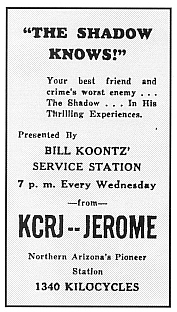
Brandon interviewed Flossie McClellan, who in 1981 had just celebrated her 79th birthday.
She told Brandon how one young man carried on a lengthy courtship where a young man would every day call up and have Flossie play requests for the young lady he was in love with. She also told Brandon that most of the men were employed by the mines so it was easy for her to get a job as an announcer.
About the final days at KCRJ she seemed also saddened about itís demise.
"We left for work early that morning because we knew it was going to be the last day.......They came by the house and got me..... and Evelyn was there when we got there...I think that none of us wanted to talk very much is what it was... It was about noon that we closed it down....."
Mary Evelyn Starkovich another part time announcer in the final days of KCRJ, who came over from the high school to work. Her father was a miner at the copper mines and then later a foreman.
Mary Evelyn told Brandon how she landed the newscasterís job!
"The job was kinda exciting! I was the youngest radio announcer that they ever had in Jerome because, and I hate to admit it now, but I lied about my age to get the job! I was about 14 or 15 when I started working in the afternoon at KCRJ in Jerome Arizona! I predominantly did disc jockey type things for people who would call in and ask for certain records to be played. One night the man that owned the station had a coughing attack right around news time and he could not read the news so he asked me to fill in for him, and the switchboard was flooded with phone calls and people saying Ďlet that girl read! She can pronounce names!í So I was a young newscaster at the age of 15! The names of people and places unfamiliar some announcers were often brutalized beyond recognition especially foreign names, you would come across tongue twisters!"
Brandon asked Mary what she found to be the most gratifying aspect of working at KCRJ Jerome:
"Oh I think having the rapport with the people. We had the feeling that we were all for one and one for all."
Mary told how new births would be announced on daily news and she was proud of being able to help spread the good news!
One of the war time policies Mary related, was that they would not play a specific request dedicated to a particular person at exactly the time it was requested. This was to prevent the station from being a carrier of Ďclandestine messages' that could interfere with the U.S. war effort.
Another use of KCRJ, was to spread the word of a lost cat or dog! After the news was broadcast, the town folk, especially the younger ones, would form up search parties and spread out throughout the town in quest of the missing animal!
Mary relates the final day of broadcast:
"I donít remember what I had on... but I know there was this lump in the throat feeling that you just didnít want this day to happen....You knew it was coming, you had known for a while, but you didnít want to admit that today was the deadline... today was D-Day so to speak.... and there was sadness.. and when people are sad they donít quite know what to say to each other.... so we say nothing... you do what you have to do and perform in a robot like atmosphere.... and then you cry...."
"It was sad because it was like a little part of Jerome was dying along with the rest of Jerome, which was a very thriving community for many years prior to the time that the town did start closing the doors...the mines had closed.. the people were moving away...the war was over...and the people that had come back from the service, had gone on to colleges elsewhere or moved on to make their lives elsewhere."
"The radio station was one of the last toe-holds so to speak in the past, and when I gave the final broadcast it was with tears in my eyes as I bade farewell to all of my friends.... because we knew that the station would not be coming back, because the town as we knew it was not coming back. But it was a tearful closing because there was as I say a lot of history and memories being closed behind those doors"
In Brandonís interview Mary told him that Wayne Fernyhough was a "genius" and kept all the equipment in "Fantastic running condition"
When asked by Brandon about the final day at KCRJ Wayne replied:
"Well it was a rather sad day because so many people stopped and talked to me and asked if there wasnít some way we couldnít keep the station going, because it was a big thing in the valley and a lot of people depended on it for entertainment. It left a big void there.... it was really too bad I think..."
Wayne also told Brandon that he had enjoyed his career in electronics and that he found all of the changes exciting....
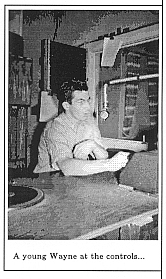
Zella Wignall, who was found by Brandon Delany under the name of Mrs. Bill Davis was the one who had trained Mary Evelyn as an announcer at KCRJ. Zella also started working for KCRJ while going to High School, and it was her first job. She was at the time a freshman in high school when her english teacher Clint Wager encouraged her to apply for an announcers job at KCRJ. She recalls her days of employment there as happy ones! Zella told Brandon that Mary Evelyn arrived on the scene shortly before Zella left to take another job.
Zella also stated that Wayneíe dedication was total, and at times it seemed that he had to hold equipment together with chewing gum and hairpins, but always had it on the air!
Being an announcer made Zella feel pretty important. Since there were only 3500 to 5000 people, everyone heard her on the radio and knew of her. She would alternate time in the day between school and KCRJ often having to really make tracks to get back and forth in time!
One name that kept coming up in each of the interview that Brandon did, was that of an announcer George Young. All of the KCRJ employees that were interviewed said he was really a fantastic announcer. I suspect that since Brandon did not interview him, he is either deceased or not able to be found. Perhaps he is still out there somewhere, I do not know, but I would sure like to interview him if he is!
The following is a transcription of the interview that we had with Wayne that afternoon in the museum.
Ed - Wayne, what brought you to Arizona?
Wayne - Well I was working at a radio shop in Los Angles, I was doing radio servicing, it did not amount to very much, but while I was going to school I had a friend at school and he got a broadcast job in Gallup New Mexico.
Ed - What was the name of the station there?
Wayne - KAWM and after he had been there for a while they needed an engineer and he asked for me, and I came over there. It was very much different there. It was my first trip to the southwest you know, and Gallup is all Indian country around it.
Ed - Kind of a wilderness around the station?
Wayne - It is a wilderness, and in about a month I was in charge of the station. It was kind of frightening because I didnít know anything about it. There was not anyone else knowledgeable within miles and miles! There were not any radio parts stores around either. It was a lot of fun... and I liked it very much, but after a year and a half I got tired and figured that I could make a little bit more money ...so I made a trip to San Diego.
Ed - What year was this?
Wayne - It was in 1939, there was no work in San Diego at all, you couldnít get a job, so I went up to Los Angles, and I got work there, I didnít like it too much though...... I then got a call from Globe, Arizona. They needed someone up there.
Ed - What radio station was that?
Wayne - KWJB I believe... And I was there a short time, and the station changed hands.. and I was gone again! So I came to Phoenix, and I got a job right away at a radio store.. most of my work was installing mobile transmitters and receivers in police cars, as well as auto radios for people. Motorola radio, had the cream of the crop in radio transmitters and receivers. They had everyone beat for a while there.
Ed - From there you went to Jerome?
Wayne - Yea I had an application in, and they needed an engineer
Ed - Did radio station engineering pay better or did you prefer the work over the installation job?
Wayne - I preferred the engineering work; I thought I would like it better.....
Ed - What was the date that you went to Jerome to work at KCRJ?
Wayne - I was at KCRJ from May 15, 1941, to July 1, 1944.
Ed - Then 1944 was when KCRJ ceased operation?
Wayne -Yes thatís right.
ED - When you arrived at the station, what exactly did you find? What was it like? Was it what you expected?
Wayne - No.... They had a dirt road running across from the old Black Canyon Road, in the mountains, but it was a shortcut instead of going through Prescott. It was a pretty rough road.....and I came around the curve you could see the whole town it was amazing.... beautiful... you could see Flagstaff Peaks.. the town itís self was quite exciting.. there were people on the streets day and night.... but the station did not amount to much!
Ed - Who owned KCRJ at that time?
Wayne - W.P. Stewart of Prescott owned it. He also published the Prescott Courier as well..
Ed - What the station and equipment like when you arrived?
Wayne - It was the only station the folks could get in the daytime up there, so we had a lot of listeners!
Ed - What was the power output of the station?
Wayne - 250 watts daytime and 100 watts nighttime.
Ed - What hours was the station on the air?
Wayne - 8 oíclock in the morning until 9 in the evening.
Ed- You mentioned that you functioned there as an announcer there also in the evening?
Wayne - Yes, and I had special programs as well and also monitored the studio work.
Ed - Did you sell advertising?
Wayne - Oh sure!
Ed - Then you sort of had to do everything!!
Wayne - Oh! You had to do everything.. even write your own script!
Ed - How many were working at that station then?!
Wayne - When I started there was another engineer, there was a manager and his wife, and sometimes someone, a girl would come in and do some talking.... Talk shows... Just the four of us....
The manager would go out and sell the advertising, an his wife would do the book work and help write up scripts. There were two of us engineers that took care of the transmitters and took care of the board......
Ed - When did the mines start to die out?
Wayne - They were digging out some real low grade ore at that time, they really needed anything that they could get due to the war. When they knew the war was ending.. they said the mine had to close. A great many of the miners.. all the active miners went with Phelps Dodge. Some went to Miami and some to Morenci....
Ed - So basically the towns real existence was just to house the miners then?
Wayne - Thatís all! The miners were paid real good wages and they were pretty good spenders also. The miners were loyal to the town so it was really a good little town... The school had football and baseball teams that played all over the state. They took a lot of the games too... they were good!
Ed - When did you finally get the word that the station was to be sold? How did they present that to you?
Wayne - They had been telling me that they were going to sell the station.... They had suggested to me that I get a job at the mine.... I worked for about six months at the mine as well as at the station... I worked all sorts of shifts.. I never knew if it was day or night! It was rough!
Ed - They knew that the mines would close and time to sell the station while it was still worthwhile?
Wayne - Yes, All the equipment was obsolete.......
Ed - Tell me a bit about the equipment.. What type of tubes did it use?
Wayne - I believe it had 4 805ís in it and two large tubes in the modulator....It was all composite.....The amplifiers were all composite.....
Ed - What do you mean by "COMPOSITE"?
Wayne - Well.... just put together by someone...
Ed - Oh! you mean Home Brew! Garage Grown!
Wayne - Yes! It was pretty good equipment though, it never really gave us much trouble.
Ed - So you didnít have to have it type-accepted to put it on the air as you do today?
Wayne - Oh yes... Certainly you did,.....
Ed - They would built it then have it type accepted then?!
Wayne - It was pretty common in the early days but now the big companies have it sowed up now..... In those days all stations had to have a first class engineer on duty at all times....... About 1950, they changed that... smaller stations only had to have the engineer on call and the announcers could take care of the equipment, and that cut down on an awful lot of help!
Ed - But most announcers I have seen have never been very technically inclined...
Wayne - Oh Geez! It was a big headache! They would never even attempt to learn anything at all!
Ed - When KCRJ closed was there both yourself and the other engineer there?
Wayne - He left six weeks after I got there! He claimed that due to health reasons he had to go to a lower climate, he said his lungs were giving him all sorts of trouble. Later I found out he went to Grand Junction, Colorado.
Ed - Thatís not much lower is it?!
Wayne - No! Higher! I think it is higher! He got a better job at twice the pay! About that time the manager was looking for another man to help me.. and weeks and weeks went by.... and he asked me if I would take the whole shift!
Ed - Thatís 13 hours Wayne!
Wayne - Thatís seven days a week also, except on Sunday we would quit about 2 or 3 oíclock.
Ed - Was the pay any better or did you just have to take the extra shift?
Wayne - Oh Yes, I got more money! Oh Yes! But if I had quit, I am sure the station would have quit.....
Ed - Did the manager understand how the transmitters worked?? Was he technically inclined at all?
Wayne - No! Not at all!
Ed -So it was all a mystery to him then!! You have mentioned that there were no schematics for the transmitter?
Wayne - No there was none of those.. there was no spare equipment either there was no supply house closer than Phoenix! Heh Heh!
Ed - Did you keep a stock of spare parts on hand at all?
Wayne - No we didnít!
Ed - What happens if you have a final go out?
Wayne - Well, there was usually a used one around you could throw in until you ordered a new one.... They didnít have any money to operate on... it was sort of a sketchy thing....
Ed - Sounds like quite an experience...Now finally they sold the station, who did they sell it to?
Wayne - They sold it to a man in North Carolina. He had a permit and a transmitter and all the equipment, but because of the war he did not have a frequency monitor and he had to have one before he went on the air... he paid a lot of money for a couple pieces of equipment......
Ed - I would suppose some of the microphones would have been used also then?
Wayne - They were just little cheap crystal microphones... The turntables were not much either.. a couple green flyer motors to play transcriptions on....
Ed - What was the fellows name that purchased the equipment?
Wayne - Alston, W. J. Alston June 27, 1944.... I think that was before it actually went off.... Here is a list of the equipment that was used at the station...( Wayne then read it off the list reproduced in previous pages of this interview.)
Ed - How did you end up with the Amperite Ribbon microphone?
Wayne - I though it would be nice to have a piece of the equipment and it was no good to anyone, and it was all that I got... it was all I had room for!
Ed - Were you married at the time?
Wayne - Yes, When I left there I had a 1929 Plymouth†Coupe, and I had everything I owned in there when I left to come back to Phoenix.
Ed - We are really glad that Lou Burke let us have this microphone for the museum here. It is nice to have for display!
Wayne - Yes it is!
Ed - Where was the station located? Was it in the jewelry building?
Wayne - No, (reaching into his scrapbook) Here are some pictures of the station, and here is one of me announcing! Here is a picture of the back of it, there was room in the back there and that is where I would live.....
Ed - Is that your wife there by the door with you?
Wayne - Yes it is... This is the only picture of the outside of the station that I have been able to get. I have asked the people up at Jerome, but they do not have any.
Ed - Well Wayne, what happened when the big day came to move the station?
Wayne - Well, we had everything packed, and I do mean everything! They built a big wooden crate for the transmitter.
Wayne then showed me several documents that were the orders from the new owner that he was exercising the option to purchase the station and that he wanted every thing packed up, including the ground rods that were not buried too deeply! This is of course understandable due to the critical materials shortage that was common place during World War II. Everything was at a premium in those days!
Wayne told us that it was easier to set up a radio station in the early days, as small towns really welcomed radio broadcasting in their area. The station became the nerve center of the town, and in Jerome when a cat would get lost, there would be announcement about it on the radio!
We also discussed the fact that many AM stations are in poor financial shape, and perhaps in the future that some of the neat old radios from the 20ís and 30ís may not have any stations to receive. Wayne also stated, that perhaps in the far future that all programming will come out of one central source. Although this sounds perhaps a bit Orwellian, We will have to wait to see what the future brings ...when it happens.... --EAS
|
